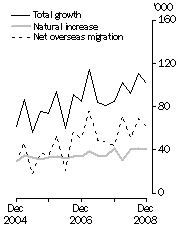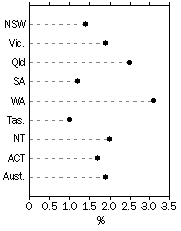09/06/2009 Note: Due to a formatting issue with Table 6, this data cube has been re-released. The data cells in Table 6 and all other tables have not changed.
DECEMBER KEY FIGURES
 | Population at end Dec qtr 2008 | Change over previous year | Change over previous year |
| PRELIMINARY DATA | '000 | '000 | % |
|
| New South Wales | 7 041.4 | 97.5 | 1.4 |
| Victoria | 5 364.8 | 102.4 | 1.9 |
| Queensland | 4 349.5 | 106.7 | 2.5 |
| South Australia | 1 612.0 | 18.5 | 1.2 |
| Western Australia | 2 204.0 | 66.0 | 3.1 |
| Tasmania | 500.3 | 4.9 | 1.0 |
| Northern Territory | 221.7 | 4.2 | 2.0 |
| Australian Capital Territory | 347.8 | 5.8 | 1.7 |
| Australia(a) | 21 644.0 | 406.1 | 1.9 |
|
| (a) Includes Other Territories comprising Jervis Bay Territory, Christmas Island and the Cocos (Keeling) Islands. |
Population growth

| Population Growth Rate, Year ended current quarter

|
DECEMBER KEY POINTS
ESTIMATED RESIDENT POPULATION
- The preliminary estimated resident population (ERP) of Australia at 31 December 2008 was 21,644,000 persons. This was an increase of 406,100 persons (1.9%) since 31 December 2007 and 101,500 persons since 30 September 2008.
- Preliminary natural increase recorded for the year ended 31 December 2008 (152,700) was 3.1% (or 4,600 persons) higher than the natural increase recorded for the year ended 31 December 2007 (148,100).
- Preliminary net overseas migration for the year ended 31 December 2008 was 253,400 persons.
POPULATION GROWTH RATES
- Australia's population grew by 1.9% during the 12 months ended 31 December 2008. Natural increase and net overseas migration contributed 38% and 62% respectively to this total population growth.
- All states and territories experienced positive population growth over the 12 months ended 31 December 2008. Western Australia recorded the largest percentage gain (3.1%) and Tasmania the smallest (1.0%).
 Quality Declaration
Quality Declaration  Print Page
Print Page
 Print All
Print All